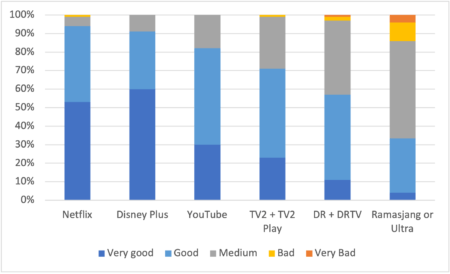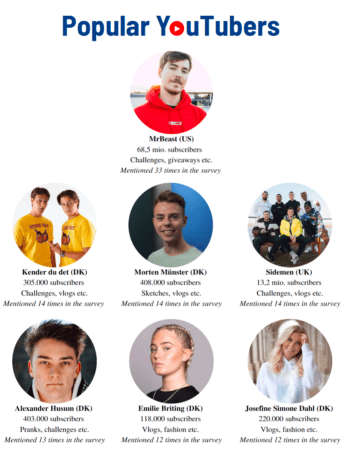At the end of 2021, we published a report in the Reaching Young Audiences project based on a national survey (N=313) of 8-17-year-old Danish children and teenagers exploring how they relate to various fictional screen content and the platforms that provide it. The report offers quantitative insights into children’s use of, and relationship with, Danish and international providers of fictional screen content, namely Netflix, Disney+, YouTube, TV 2, DR and Ramasjang/Ultra, as well as qualitative findings relating to their favourite YouTube channels, films and TV series and their opinions on 14 specific films and series.
The report, including the survey methodology, can be read in its entirety here but below we outline the 10 major take-aways from the survey:
- Danish 8-17-year-old children and adolescents have a strong preference for global content providers Netflix, Disney+ and YouTube. They are less enthusiastic about Danish DR, TV 2 and Ramasjang/Ultra.
- YouTube is the most frequently watched platform by children in general with daily viewing figures of 40% (comprising two-thirds of boys) watching daily. Netflix is the second most frequently watched platform.
- When it comes to film and TV series, Danish children and adolescents mainly watch them on Netflix and Disney+. They sometimes watch films and series on the Danish platforms, but there they also watch a variety of other genres such as news, documentaries, entertainment and reality. YouTube is used less to watch films and series.
- There are significant differences between the genders. The most preferred genre amongst boys is gaming content on both YouTube and Ramasjang/Ultra. Gaming is considerably less important among the girls, who would rather spend their time watching fiction and their favourite YouTubers.
- As for the children’s favourite series and films, most of the titles mentioned originate in the US although they also mention a few films and series from Denmark and elsewhere, e.g., the UK.
- Among the respondents’ favourite movies, a significant amount belongs to global franchises such as Marvel, Disney, Harry Potter, Star Wars and Netflix Originals. Netflix Originals take centre stage when it comes to their favourite series.
- When it comes to YouTube content, however, the sample respondents seem to like Danish content: 5 of the 7 most favourite YouTube channels belong to Danish YouTubers.
- When our sample respondents were asked to rate specific trailers and clips, they were the least impressed with arthouse titles and the most enthusiastic about genre-driven films and series from commercial market players.
- The respondents’ comments on the specific titles give nuance to the quantitative ratings. The comments show that youngsters are not necessarily uncritical of the commercial content and completely dismissive of arthouse content.
- Some comments did, however, leave an impression of a general reluctance towards Danish content, either because of a perceived poor quality in storytelling and production values or simply because of the fact it is in Danish.
Many findings are in line with those from reports by other institutions such as The Danish Film Institute (Kofoed et al. 2020)[1], The Ministry of Culture (2021, 2020), DR (2021, 2020), Medierådet for børn og unge (2021), and Nordisk Film (2021). One such finding is that Danish children prioritize English-language films and series and show only marginal interest in films and series in languages other than Danish or English. Moreover, Danish children very much like what they watch on global US platforms such as Disney+ and Netflix and spend a considerable amount of time on YouTube (although films and series add very little to the list of videos Danish children watch on YouTube).
However, the findings in this report also offer a nuance to these general trends. While Danish children undoubtedly prefer American streaming platforms to the domestic public service content, they still use the public service platforms to watch a variety of non-fictional formats such as news, documentaries, reality and gaming. From around the age of 10 Danish children essentially shift to watching films and series on global platforms, marginalizing domestic and public service content. At the same time, Danish children are not uncritical of the content they encounter here. They appreciate the “high-quality” production standards of streaming services like Netflix, but not unconditionally.
Going forward from here, we are currently in the process of investigating the findings more in depth via qualitative methods, not least in order to refine and understand the nuances behind the ‘whys’ of these take-aways. To this end, we have designed an ethnographic study of 20 children and adolescents. This ethnographic study will address issues such as US versus Danish content; YouTube’s relevance; gaming versus fictional content; what makes a good story; etc.
To be continued…
Pia Majbritt Jensen is Associate Professor at the Department of Media Studies and Journalism and Director of The Media, Communication and Society Research Programme at Aarhus University. An audience, industry and production scholar, her current research projects include the Researching Young Audiences project mentioned here and an EU Horizon 2020 project on European crime narratives. She has published widely and is the co-editor of New Patterns in Global TV Formats (Intellect, 2016), The Global Audiences of Danish Television Drama (Nordicom 2020), and Danish Television Drama: Global Lessons from a Small Nation (Palgrave Macmillan, 2020).
Petar Mitric is Assistant Professor in the Section of Film Studies and Creative Media Industries at the University of Copenhagen. His research interests span audience-design practices, audiovisual policies, and film & TV co-production.
Footnote
[1] For more information about this report, see our CSTonline blog from September 2020 at https:///how-do-children-watch-fiction-in-denmark-and-what-content-do-they-prefer/#comments
References
Hansen, Martin Kofoed, Lena Juhl Seidelin and Louise Haugstrup Jensen (2020). VIDSTE DU? – Om de 7-14-årige. Danish Film Institute: Copenhagen.
DR (2021), Medieudviklingen 2021.
DR (2020), Medieudviklingen 2020.
Kulturministeriet 2021, Mediernes udvikling i Danmark: Streamingtjenester.
Kulturministeriet 2020, Mediernes udvikling i Danmark: Overblik og perspektivering.
Medierådet for børn og unge (2021), Børns spillevaner.
Nordisk Film (2021), Nordisk Film Consumer Insight Study.









Dear Pia and Petar,
Thank you for this – *absolutely* fascinating and offering me sets of data which rather reinforce some conclusions that my wife and I were having the other day about children’s viewing habits (yes – that’s the kind of wildly exciting couple we are; don’t have children, but still pass our leisure time discussing children’s viewing habits…). So it’s nice to have our gut reactions and suspicions based on Very Little Evidence Whatsoever sort of affirmed.
As I saw, fascinating stuff. I think I’ll be flagging this up to a few colleagues…
Much appreciated! 🙂
Hoping that this finds you and yours safe and well.
All the best
Andrew